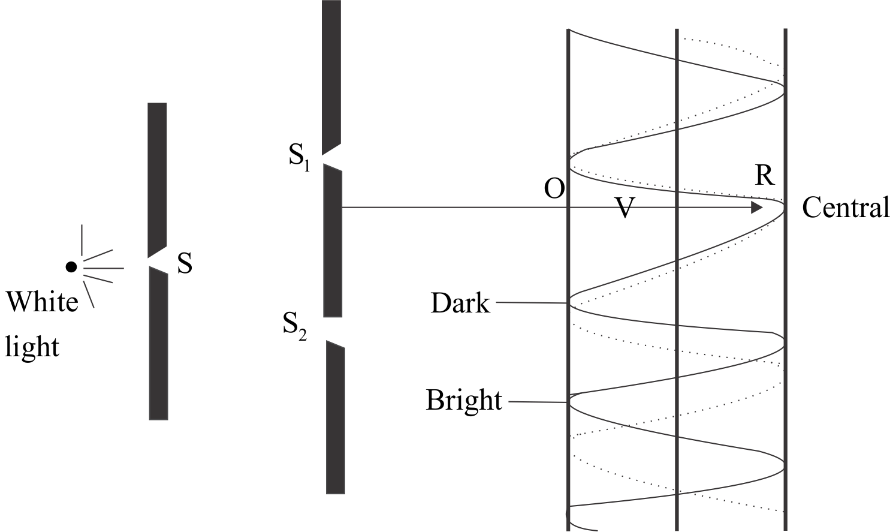
What changes occur if the monochromatic light used in Young’s double-slit experiment is replaced by white light?
\[\left( A \right)\]Only the central fringe is white and all other fringes are observed colored.
\[\left( B \right)\]No fringes are observed.
\[\left( C \right)\]All the bright fringe becomes white.
\[\left( D \right)\]All the bright fringes are colored between violet and red.
Answer
512.6k+ views
Hint: To answer this question we should know Young’s double-slit experiment. Don’t worry if you don’t know about this. We will let you know through this question and will explain the reason behind the central fringe which becomes white.
Answer White light consists of waves of innumerable wavelengths ranging from violet to red color. So if monochromatic light in Young’s double-slit experiment is replaced by white light, then the waves of every wavelength form their separate interference patterns.

The resultant impact of these patterns is obtained on the screen. The path distinction between waves ranging from \[{S_1}\]and \[{S_2}\]at the location \[R\] of the central fringe is zero that is for the point \[R\] of the screen so the path difference will be zero.
Hence the waves of all colors reach a middle point \[R\] in the same phase. So the central fringe is white. As the fringe dimension that is the wavelength will increase so as colors denoted by VIBGYOR so on either aspect of it some colored fringes are obtained in the order of color VIBGYOR. That's the violet fringe seems first and therefore, the red in the last. When this the fringes of many colors overlap at every purpose of the screen then the screen seems uniformly illuminated. Thus, if we tend to use white light in place of monochromatic light the central fringe is white, containing on either aspect several colored fringes in order VIBGYOR and therefore, the remaining screen seems uniformly illuminated.
Therefore the \[Option{\text{ A}}\]will be the right choice as only the central fringe is white and all other fringes are observed colored.
Notes: Young’s double-slit experiment uses two coherent sources of light placed at a little distance apart, usually, solely orders of magnitude bigger than the wavelength of light is used. Young’s double-slit experiment helped in understanding the wave theory of light.
Answer White light consists of waves of innumerable wavelengths ranging from violet to red color. So if monochromatic light in Young’s double-slit experiment is replaced by white light, then the waves of every wavelength form their separate interference patterns.

The resultant impact of these patterns is obtained on the screen. The path distinction between waves ranging from \[{S_1}\]and \[{S_2}\]at the location \[R\] of the central fringe is zero that is for the point \[R\] of the screen so the path difference will be zero.
Hence the waves of all colors reach a middle point \[R\] in the same phase. So the central fringe is white. As the fringe dimension that is the wavelength will increase so as colors denoted by VIBGYOR so on either aspect of it some colored fringes are obtained in the order of color VIBGYOR. That's the violet fringe seems first and therefore, the red in the last. When this the fringes of many colors overlap at every purpose of the screen then the screen seems uniformly illuminated. Thus, if we tend to use white light in place of monochromatic light the central fringe is white, containing on either aspect several colored fringes in order VIBGYOR and therefore, the remaining screen seems uniformly illuminated.
Therefore the \[Option{\text{ A}}\]will be the right choice as only the central fringe is white and all other fringes are observed colored.
Notes: Young’s double-slit experiment uses two coherent sources of light placed at a little distance apart, usually, solely orders of magnitude bigger than the wavelength of light is used. Young’s double-slit experiment helped in understanding the wave theory of light.
Recently Updated Pages
Excess Pressure Inside a Liquid Drop Explained

Fluid Pressure Explained: Definition, Formula & Examples

Impulse Momentum Theorem Explained: Formula, Examples & Applications

Inertial and Non-Inertial Frames of Reference Explained

Ionisation Energy and Ionisation Potential Explained

Addition of Three Vectors: Methods & Examples

Trending doubts
JEE Main 2026: Application Form Open, Exam Dates, Syllabus, Eligibility & Question Papers

Derivation of Equation of Trajectory Explained for Students

Hybridisation in Chemistry – Concept, Types & Applications

Understanding the Angle of Deviation in a Prism

Understanding Collisions: Types and Examples for Students

How to Convert a Galvanometer into an Ammeter or Voltmeter

Other Pages
JEE Advanced Marks vs Ranks 2025: Understanding Category-wise Qualifying Marks and Previous Year Cut-offs

Understanding Atomic Structure for Beginners

Ideal and Non-Ideal Solutions Explained for Class 12 Chemistry

Degree of Dissociation: Meaning, Formula, Calculation & Uses

Understanding Electromagnetic Waves and Their Importance

Understanding the Electric Field of a Uniformly Charged Ring




